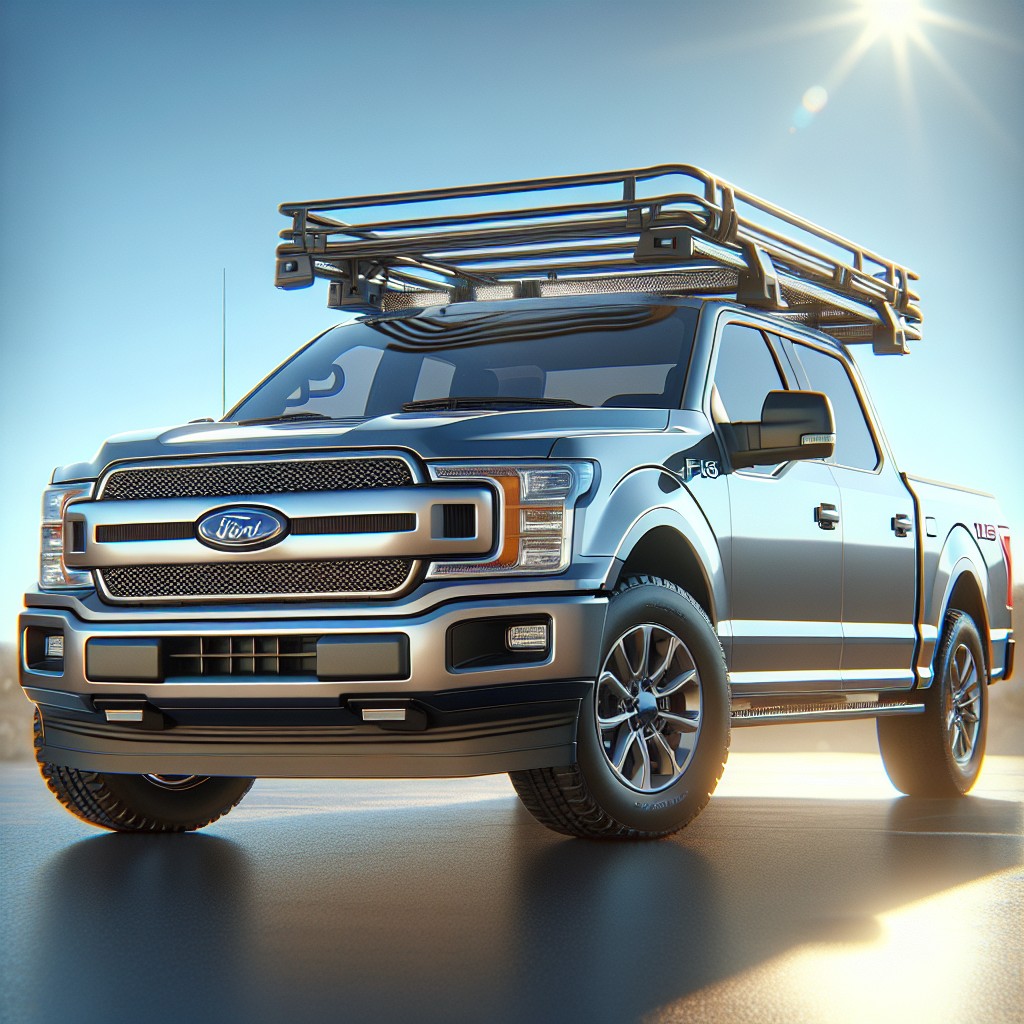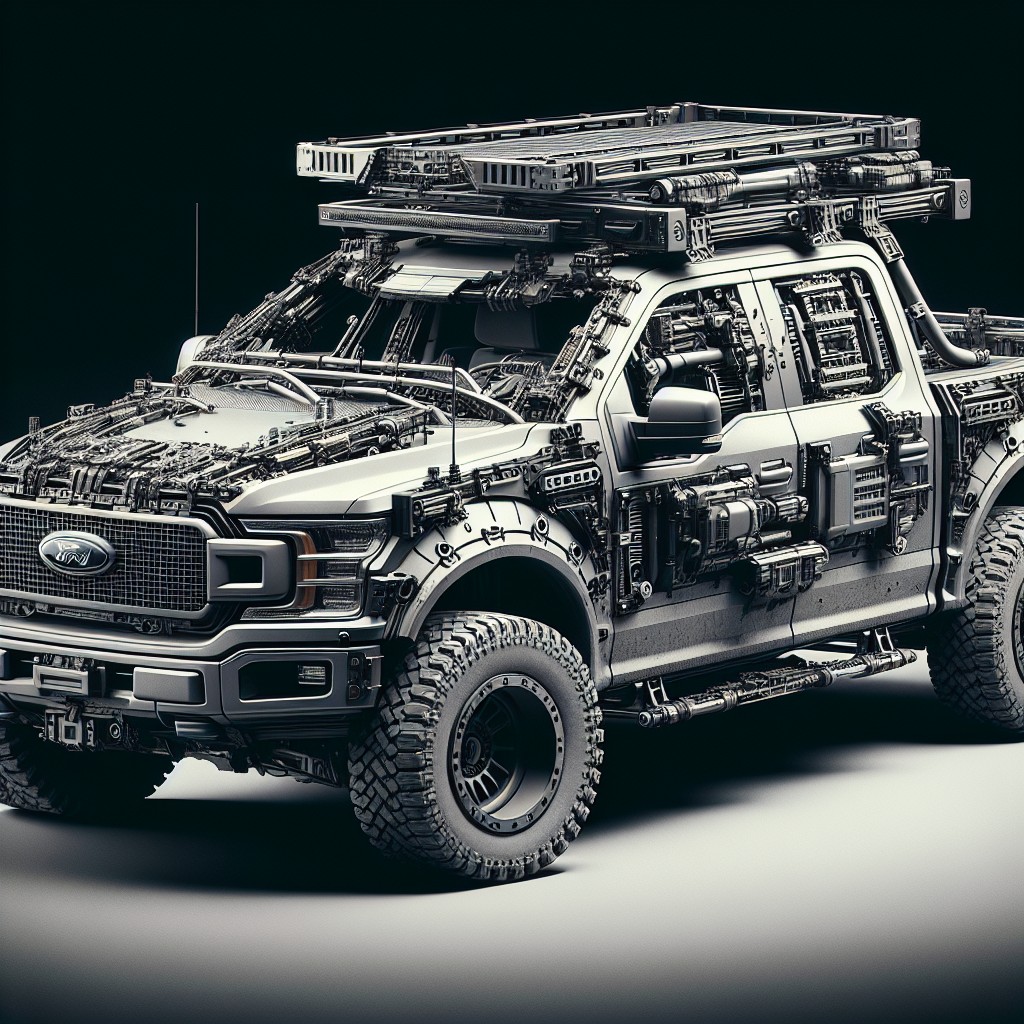Last updated on
Explore the multitude of F150 roof rack options, because selecting the right one can maximize your vehicle’s storage and enhance your travel experiences.
Key takeaways:
- Compatibility with specific F-150 models and roof configurations
- Choose between lightweight aluminum or durable steel materials
- Consider weight capacity and distribute load evenly
- Follow proper installation process for stability and safety
- Maximize utility with accessories, but consider cost and aerodynamics
Compatibility With Ford F-150 Models

Certain roof racks are designed specifically for particular F-150 models and years, taking into account the roof’s dimensions and structure. To ensure the right fit, check the manufacturer’s compatibility list.
Models often have different roof designs; for instance, a Crew Cab variant might have a different rack requirement than a Regular or SuperCab. Additionally, some racks are universally fitting but may require additional fitting kits or adjustments.
It’s essential to verify if the existing or chosen roof configuration, such as having a sunroof or a built-in satellite antenna, affects rack installation. Always cross-reference the make, model, year, and roof type of your F-150 against the roof rack specifications before purchase.
Materials and Construction

Roof racks for the F-150 are typically crafted from robust materials like aluminum or steel. Aluminum racks are lightweight and resist corrosion, offering a long lifespan and minimal impact on fuel economy. Steel, on the other hand, is known for its strength and durability, although it tends to be heavier and may require a protective coating to prevent rust.
The construction of a roof rack often involves either a solid one-piece design or a modular setup. One-piece racks offer ease of installation with a sturdy build, while modular systems provide flexibility, allowing for a customized fit and the option to add additional sections or accessories as needed.
Welding quality is another crucial aspect, with high-quality welds ensuring the rack components maintain their integrity and safety under load. Powder coating is also a popular finish for metal racks, providing an additional layer of durability against scratches and the elements.
Choosing racks with UV-resistant plastics for any non-metal components can further extend the lifespan of the rack by preventing cracking and degradation from sun exposure.
For the discerning Ford F-150 owner, the choice in materials and construction plays a significant role in the performance and longevity of their roof rack system.
Weight Capacity and Load Limits
Understanding your F-150’s roof rack weight capacity is crucial for both safety and vehicle integrity. Each roof rack system has a maximum load limit, typically ranging between 100 to 165 pounds, which manufacturers rigorously test under various conditions.
It’s essential to consider the dynamic weight limit—how much the rack can hold when the vehicle is in motion—versus the static weight limit, which is higher and accounts for the load when the truck is parked.
When loading your roof rack, distribute weight evenly to prevent any potential vehicle imbalance. Overloading can compromise the rack’s structure and potentially damage the roof of your truck. It’s also critical to factor in the weight of the roof rack itself when calculating the total weight being added to your vehicle.
Remember, for safe handling and to mitigate the risk of accidents, adhere strictly to the specified load limits outlined in your F-150 owner’s manual as well as the roof rack’s instruction guide. Regular checks are recommended to ensure that neither the load exceeds the limit nor does it shift during transit, which could affect the vehicle’s center of gravity and handling.
Installation Process
Before beginning the installation, ensure that the vehicle’s roof is clean and free of debris. This prevents scratches and ensures a secure attachment of the rack. Review the manufacturer’s guide thoroughly as the instructions may vary between different models and rack systems.
Most F-150 roof racks require no drilling, using clamping systems that attach to the truck’s factory mounting points or the door jamb. Align the clamps or mounting feet with these points, which are typically located on or near the truck’s rain gutters.
Tightening bolts and fasteners should be done systematically, alternating sides to balance the pressure and prevent warping. Use a torque wrench to ensure you apply the correct amount of force as specified by the rack manufacturer.
Once the base is secure, crossbars can be added. Adjust them to the appropriate width for your load before tightening. Ensure that end caps and any locking mechanisms are fitted to protect against theft and weather damage.
After installation, perform a pull test on the rack to check for stability. Lastly, it’s wise to regularly check all fittings for tightness, especially after the first few uses, as they can settle and require adjustments.
Aerodynamics and Impact On Fuel Efficiency
Understanding the interaction between airflow and vehicle design is crucial when adding a roof rack to your F-150. A well-designed rack minimizes drag—a force that opposes the vehicle’s motion—thus reducing the impact on fuel efficiency. These systems should ideally follow the shape of the vehicle to create a seamless profile that allows air to pass over smoothly.
When loading items onto the rack, arrange them to present the smallest possible profile to the oncoming air. Bulky items should be placed in the center, between the roof’s peak and the rack’s sides, to help maintain a streamlined shape. Soft bags can conform to the rack’s dimensions better than hard cases, offering a marginal improvement in aerodynamics.
Remember, an empty rack can still create drag. If not in use, consider removing modular components to enhance your truck’s aerodynamics. Seasoned truck owners recommend periodic evaluations—observing changes in the F-150’s miles per gallon after an outing can improve your understanding of how rack configuration affects fuel consumption.
Choosing a roof rack with an integrated wind deflector can also help. These attachments redirect airflow over the rack and cargo, cutting down on turbulence and noise while maintaining better fuel economy than racks without this feature.
Roof Rack Accessories and Add-ons
To maximize the utility of your F-150 roof rack, numerous accessories are available to tailor the rack to your needs. Crossbars can be added to provide a stable platform for cargo, and kayak mounts or bike racks are ideal for outdoor enthusiasts. Cargo boxes offer a secure way to transport gear while protecting it from the elements, and basket-style carriers are perfect for hauling bulky items.
For those seeking extra security, locking mechanisms can be installed to deter theft. Tie-downs and straps are essential for safely securing payloads, ensuring stability while in transit. To improve accessibility, side steps may be employed, allowing for easier loading and unloading of equipment. Lighting options, such as LED bars, can be mounted to enhance visibility for night-time adventures.
Selecting the appropriate accessories can transform your F-150 roof rack from a simple carrying solution into a versatile, multipurpose system. Remember to always verify compatibility with your specific rack model before purchasing add-ons.
Common Mistakes to Avoid During Installation
To ensure a smooth installation of your F-150 roof rack, take note of these critical points:
- Ignoring the manufacturer’s instructions can lead to improper fitting. Always follow the guide provided step-by-step.
- Failing to use all the mounting components included may compromise the rack’s security. Double-check that you have all necessary parts before starting.
- Over-tightening bolts and brackets can damage both the rack and the vehicle’s roof. Be firm yet cautious when securing components.
- Neglecting to properly align the roof rack can result in uneven weight distribution and potential hazards while driving. Use a level and measure the placement for precision.
- Skipping regular inspections post-installation could mean missing early signs of wear or loose fittings. Periodically check the rack to maintain safety and performance.
Roof Rack Safety and Use Guidelines
Adhering to safety guidelines is paramount when using a roof rack on your F-150. Below are some points to ensure secure usage:
Distribute Weight Evenly:
Even distribution prevents imbalance and potential vehicle control issues. Place heavier items in the middle and lighter ones around them.
Check Load Stability:
Before setting off and regularly during your journey, verify that all items are stable and securely tied down to prevent shifting or loss on the road.
Monitor Height Restrictions:
Be aware of the increased height of your vehicle to avoid collisions with low-clearance barriers like garage entries or overpasses.
Adhere to Weight Limits:
Respect the manufacturer’s specified weight capacity to avoid roof damage or compromise vehicle dynamics.
Regular Inspections:
Inspect the roof rack and its mounts before and after trips for wear or damage. Ensure bolts and screws are tight.
Know Your Tying Techniques:
Practice using ratchet straps and ropes to master the art of securing loads effectively.
Consult the Manual:
Always review your vehicle and roof rack manuals for tailored advice regarding safe and proper use.
These points will help maintain safety and the integrity of your vehicle while using a roof rack.
Cost Considerations and Budgeting
When budgeting for a roof rack system, it’s essential to factor in both the upfront purchase price and potential long-term costs. Quality models can range from modestly priced steel options to premium aluminum designs that command higher price tags. Consider durability and resistance against rust or corrosion, which can affect replacement frequency and therefore, lifetime expense.
Opting for modular systems may offer initial savings, with the flexibility to add components as needed. However, ensure that the foundational parts can support future expansions to avoid unnecessary replacement costs.
Installation costs can also vary. DIY kits can save labor fees, but only if you have the required tools and confidence. Professional installation guarantees safety and might come with a service warranty, justifying the extra cost.
Lastly, don’t overlook the impact on fuel efficiency. More aerodynamic systems may cost more upfront but could lead to significant savings on gas over time, particularly for frequent users.
Making informed decisions based on these cost factors will help maintain the balance between quality and budget, ensuring long-term satisfaction with your F-150 roof rack investment.
Comparison of Ford F-150 Roof Rack Brands
Selecting the right brand for a Ford F-150 roof rack involves evaluating reputation, material quality, and design features.
Thule, known for its durable and versatile designs, offers racks that are easily adjustable and have a quick installation process. Their products, while on the higher end in terms of cost, often lead in durability and usability.
Yakima stands out with its aerodynamic designs that aim to reduce wind noise and drag, making them a preferred choice for those who prioritize fuel efficiency and a quieter ride.
Rhino-Rack is recognized for both heavy-duty construction and a variety of fitment options, catering to those who may have more specialized hauling needs, such as carrying over-sized cargo or heavy equipment.
Rola brings a balance of cost-effectiveness and reliable performance, with straightforward designs that cater to budget-conscious consumers without sacrificing on quality.
Every brand offers a warranty for their products, providing additional peace of mind; however, warranties vary in length and coverage, making it another factor for consideration.
In summary, when comparing brands, focus on matching your specific needs with the features each brand emphasizes, such as durability, noise reduction, or cost to find the perfect fit for your F-150.
FAQ
Can you put a roof rack on an F150?
Yes, you can install a roof rack on an F150, as various models compatible with the vehicle are available.
What are the disadvantages of a roof rack?
The primary disadvantages of a roof rack predominantly stem from the added weight it imposes on the vehicle that leads to increased aerodynamic drag causing higher fuel consumption, in addition to the obligation of consistent fitting and maintenance.
What is the difference between roof rails and roof racks?
Roof rails run along the length of a vehicle from hood to trunk, whereas roof racks sit cross-ways from the driver’s side to the front passenger’s side.
Are roof racks worth it?
Roof racks are worth it because they increase packing efficiency, allow for a clutter-free vehicle interior, and enable safe transportation of bulky items that wouldn’t fit inside the car.
How does a roof rack impact the fuel efficiency of an F150?
A roof rack on an F150 can lower fuel efficiency due to increased drag and added weight.
What considerations should one make when choosing a roof rack for an F150?
When choosing a roof rack for an F150, one should consider the load capacity of the rack, the dimensions of the items to be transported, the material and construction of the rack, its ease of installation, and its compatibility with the specific model and year of the F150.
What is the maximum weight that an F150 roof rack can safely carry?
The maximum weight that an F150 roof rack can safely carry is typically around 165 pounds (75 kg).




